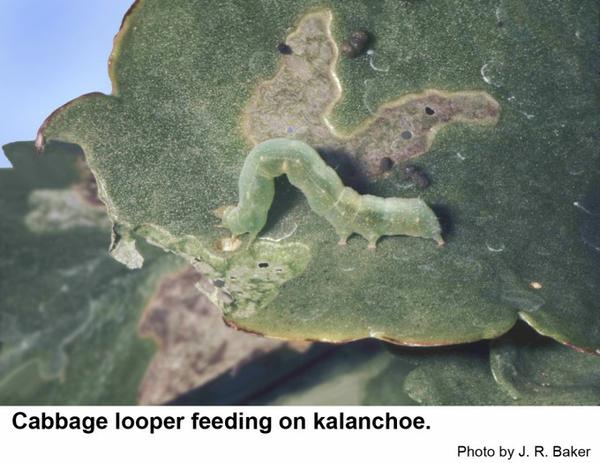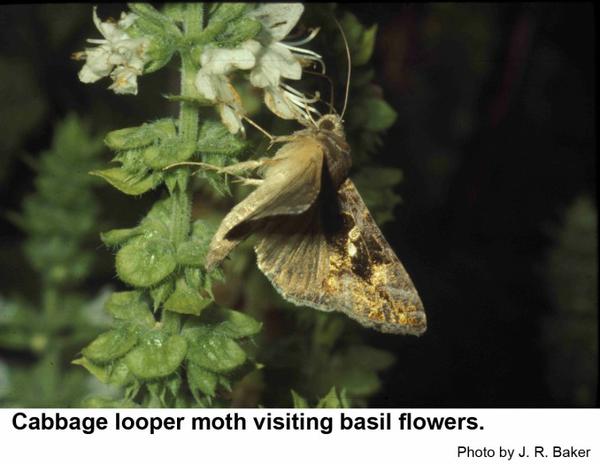Description and Biology
Trichoplusia ni is called the cabbage looper because it is a fairly predictable pest of cabbage and because the caterpillar is an inchworm that loops to bring the hind end forward as it crawls about. The worms are about 1/16 inch long when they hatch. As the larvae grow, they become light green with two white stripes on top and two wider white stripes down each side. The markings become less distinct in the last instar. The body tapers toward the head and is about 1.5 inches long when full grown. Cabbage loopers pupate in a gauzy, transparent cocoon on the plant (not in the soil the way many other moth caterpillars do). The adult is a dark, mottled moth with a conspicuous, silvery figure 8 on each forewing. It's wingspan is about 1.5 inches. The moths fly primarily at night. Females lay about 350 eggs one at a time (not in masses). In North Carolina, there are five to six generations per year, mostly on crucifers.
Host Plants
The cabbage looper feeds on most plants in the cabbage family including allysum, flowering kale, ornamental cabbage, and stock, as well as geraniums, mums, kalanchoes and almost every other ornamental plant! It is called the cabbage looper because it is a fairly predictable pest of the vegetable cabbage and related plants. Lettuce, spinach, beet, pea, celery, potato, cotton, soybean, tomato, and tobacco are other plants attacked by cabbage loopers. The caterpillars devour leaves and drop frass, which further disfigures plants.
Residential Recommendation
A high degree of natural control by predators and parasites usually keeps cabbage looper populations under control. A polyhedral virus disease seems to be a key factor in overall population suppression. Remay or some other light weight row crop cover can also be used to exclude cabbage looper moths in the right location (the vegetable garden, not a front yard flower garden!). The cabbage looper is not particularly resistant to pesticides so Sevin, Orthene or some other contact insecticide should give adequate control on ornamentals.
References
- Common name: cabbage looper, scientific name: Trichoplusia ni (Hübner) (Insecta: Lepidoptera: Noctuidae). Capinera, John L. 2020 (reviewed). Featured Creatures, Entomol.& Nematol. FDACS/DPI, Univ. Florida.
- Insect and related Pests of Flowers and Foliage Plants. Baker, J. R., ed. 1994. North Carolina Cooperative Extension Service Publication AG-136. 106 pp.
- Extension Plant Pathology Publications and Factsheets
- Horticultural Science Publications
- North Carolina Agricultural Chemicals Manual
For assistance with a specific problem, contact your local N.C. Cooperative Extension Center
The Factsheet has not been peer reviewed.
Publication date: June 27, 2013
Reviewed/Revised: Sept. 11, 2019
Recommendations for the use of agricultural chemicals are included in this publication as a convenience to the reader. The use of brand names and any mention or listing of commercial products or services in this publication does not imply endorsement by NC State University or N.C. A&T State University nor discrimination against similar products or services not mentioned. Individuals who use agricultural chemicals are responsible for ensuring that the intended use complies with current regulations and conforms to the product label. Be sure to obtain current information about usage regulations and examine a current product label before applying any chemical. For assistance, contact your local N.C. Cooperative Extension county center.
N.C. Cooperative Extension prohibits discrimination and harassment regardless of age, color, disability, family and marital status, gender identity, national origin, political beliefs, race, religion, sex (including pregnancy), sexual orientation and veteran status.



